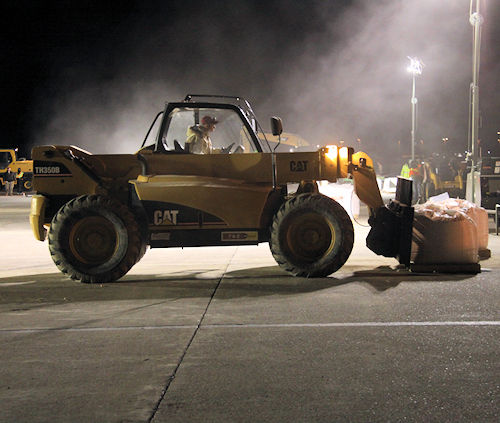18.G.29 Powered Industrial Trucks (PITs)/Forklifts and Telehandlers.
All PITs and telehandlers must meet the requirements of design, construction, stability, inspection, testing, maintenance, and operation (as defined in ANSI/ASME B56.1).
Note: When PITs or Telehandlers are configured to hoist and lower (by means of a winch or hook and/or with rigging) and horizontally move a suspended load, refer to Sections 16.A.01 and 16.Q.
- All PITs, lift trucks, stackers, and similar equipment must have the rated capacity posted on the vehicle so as to be clearly visible to the operator. When the manufacturer provides auxiliary removable counterweights, corresponding alternate rated capacities also must be clearly shown on the vehicle. The ratings must not be exceeded.
- Only trained, qualified/certified and designated operators must be permitted to operate a PIT. Qualification must be in writing via a license, permit or other documentation.
- (1) Training must be both classroom and practical operation and in accordance with OSHA Standard 29 CFR 1910.178. It must be on the same type of truck the operator uses on the job.
- (2) The employer must certify that the operator has been trained and evaluated as required by the standard. The certification must include the name of the operator, the date of the training, the date of the evaluation, and the identity of the person(s) performing the training or evaluation.
- (3) Refresher training in relevant topics must be conducted at least once every three (3) years including an evaluation of each powered industrial truck operator's performance. In addition, refresher training must be provided to the operator when the operator:
- (a) has been observed to operate the vehicle in an unsafe manner;
- (b) has been involved in a mishap;
- (c) has received an evaluation that reveals that the operator is not operating the truck safely;
- (d) is assigned to drive a different type of truck; or
- (e) a condition in the workplace changes in a manner that could affect safe operation of the truck.
- When a PIT is left unattended, load engaging means must be fully lowered, controls must be neutralized, power must be shut off, and brakes must be set. Wheels must be blocked if the truck is parked on an incline.
- An overhead guard must be used as protection against falling objects. It should be noted that an overhead guard is intended to offer protection from the impact of small packages, boxes, bagged material, etc., representative of the job application, but not to withstand the impact of a falling capacity load.
- Dock board or bridge plates must be properly secured before they are driven over. Dock board or bridge plates must be driven over carefully and slowly and their rated capacity must never be exceeded.
- Under all travel conditions the PIT must be operated at a speed that will permit it to be brought to a stop in a safe manner.
- On all grades the load and load engaging means must be tilted back if applicable, and raised only as far as necessary to clear the road surface.
- When ascending or descending grades in excess of 10%, loaded PITs must be driven with the load upgrade.
- Multi-purpose machines, material handling equipment (i.e. Rough-Terrain Forklifts, Lulls, etc.), and construction equipment used to lift loads suspended by rigging equipment must:
- (1) Have proof or authorization from the manufacturer that the machine is capable of making lifts of loads suspended by rigging equipment;
- (2) Demonstrate that the equipment is properly configured to make such lifts, and
- (3) The machine/equipment must be equipped with a load chart.
- Contractor must provide certification that the operator is trained, qualified and designated for the operation of the machine (multi-purpose, material handling and construction equipment) being utilized to lift loads suspended by rigging equipment.
Knowledge Check Choose the best answer for the question.
18-10. What must a contractor certify before an operator can use lifting and rigging equipment to suspend a load?
You forgot to answer the question!

